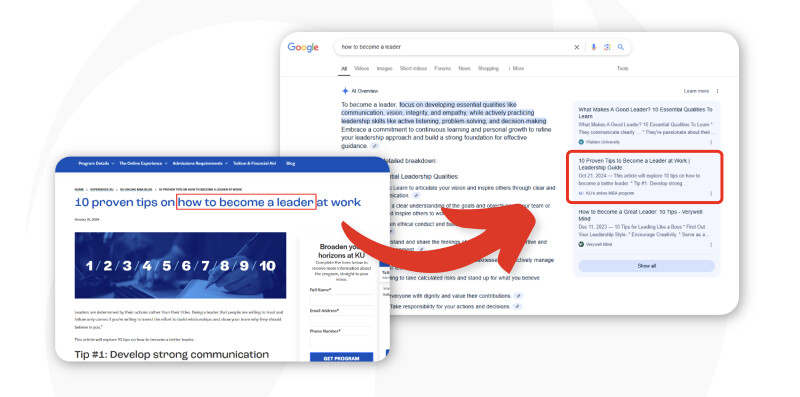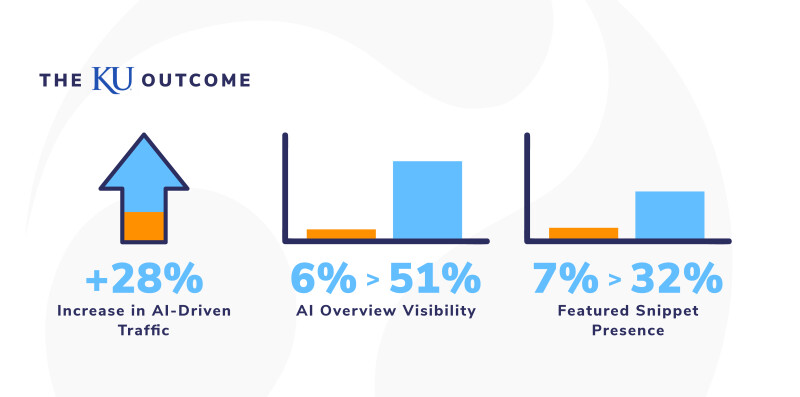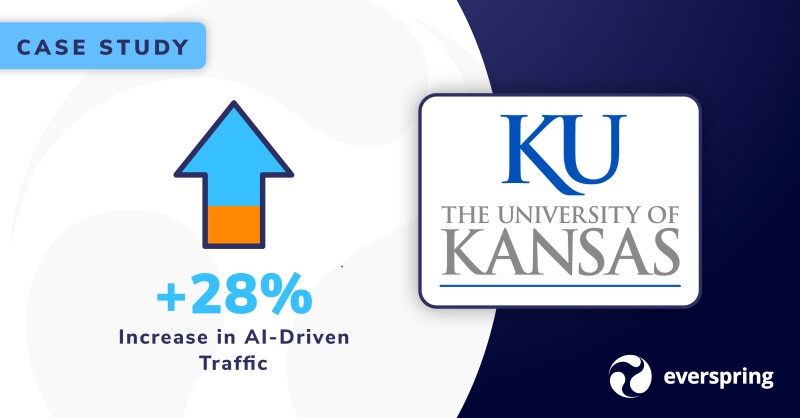Key Takeaways
- AI is changing how students discover and evaluate programs—visibility in AI Overviews is now critical.
- Traditional SEO strategies miss the mark in an AI-first world. KU succeeded by focusing on real student questions.
- A longtail, question-driven content strategy increased KU’s AI Overview presence from 6% to 51%.
- KU’s application conversion rate from AI platforms jumped 291%—proof that strategy, structure, and specificity work.
- Everspring's AI Search Strategy enabled KU to build authoritative, high-impact content that AI systems recommend.
Universities nationwide are grappling with the AI revolution in student search behavior. The University of Kansas School of Business implemented a strategic approach to longtail keywords that dramatically improved their visibility in the new AI-driven search landscape. Longtail keywords are specific, detailed search phrases people use when looking for exactly what they want, rather than using short, general terms. Here's how they did it.
The Challenge: Staying Visible in the Age of AI
The University of Kansas School of Business faced a challenge familiar to many higher education institutions in 2024: prospective students were increasingly turning to AI for program research, yet their programs weren't easily found in AI-generated results.
Initial data revealed concerning trends:
- Only 6% of top-ranking queries triggered AI Overviews that mentioned informational content
- Program-related content appeared in featured snippets for just 7% of relevant searches
- Conversion rates from organic search traffic had plateaued
The Strategy: Beyond Traditional Keywords
Rather than competing for high-volume, generic keywords like "online MBA programs" or "top MBA programs," KU School of Business developed a comprehensive longtail keyword strategy focused on the specific intent of prospective students.
1. Question Mining from Multiple Sources
The team began by gathering actual questions from:
- Admissions counselor conversations
- Live chat transcripts
- Email inquiries
- Leverage keywords from SEO tools
- Student forums
2. Content Transformation
KU School of Business restructured their content approach:
- Transformed promotional statements into question-based formats
- Leveraged longtail keywords to target high-intent searches
- Published detailed "how-to" content for application processes

3. Content Clustering for AI Understanding
The marketing team organized content into clear hierarchical structures:
- Program pages served as central hubs
- Topic clusters branched out to address specific aspects
- Blog posts that answered highly specific questions
- All content linked strategically to establish topical authority
4. Optimizing for Relevance on AI Platforms
Content was formatted specifically for AI understanding:
- Strategically placed search volume backed questions into headers for optimization
- Structured data markup provided machine-readable context
- Content was updated in accordance with search trends to maintain freshness signals
The Results: Dramatic Visibility Improvements
- AI Overview presence jumped from 6% to 51% for program-related queries
- Featured snippets increased from 7% to 32%
- Traffic from AI-driven sources increased 28%
- Most importantly, application conversion rate increased by 291% from AI platforms like ChatGPT

The most successful content focused on specific career outcomes, program comparisons, and curriculum-based content—precisely the information students needed at critical decision points.
Key Insights: What Made the Difference
1. Student-Centric Questions vs. Institution-Centric Statements
We shifted from institutional promotion to directly addressing the questions prospective students actually ask AI systems. This fundamental change in perspective transformed the content strategy and significantly improved visibility.
2. Specificity Over Volume
Pages that answer specific questions like "How to become a leader in healthcare administration with a KU MBA" dramatically outperform general program pages in AI results, despite having lower traditional search volume.
When users search for leadership-related queries, KU's highly targeted content now appears prominently in AI Overviews, creating a meaningful competitive advantage against institutions still focusing solely on high-volume generic keywords.
3. Structured Content Organization
AI systems require clear information architecture to understand relationships between topics and establish credibility. A pillar-cluster content model created logical connections between broader concepts and specific student questions, helping establish KU as an authoritative source that AI systems consistently recommend for targeted topics.
Implementation Advice for Other Institutions
For universities looking to implement similar strategies, Hunt offers these recommendations:
- Start with actual student questions - Mine your existing channels for the specific language students use.
- Focus on decision points - Identify where students compare programs and create content specifically addressing those comparisons.
- Create content clusters - Don't publish isolated pages. Build interconnected content that establishes topical authority.
- Optimize for AI and humans - Format content so AI can extract key information while maintaining authentic human voice.
- Measure what matters - Track both AI visibility metrics and human engagement metrics to understand full impact.
Final Thought: Proof, Not Positioning
There’s no shortage of noise about AI in marketing. But strategy without proof is just positioning.
Everspring’s work with the University of Kansas shows what actually drives visibility—and enrollment—in an AI-first world. This isn’t theory. It’s the only quantified case study that proves the impact of AI-optimized search on application growth.
We’re not chasing trends. We’re setting the bar.
Want to change how your programs stack up in AI Overviews? Explore our AI Search Strategy to get started.

